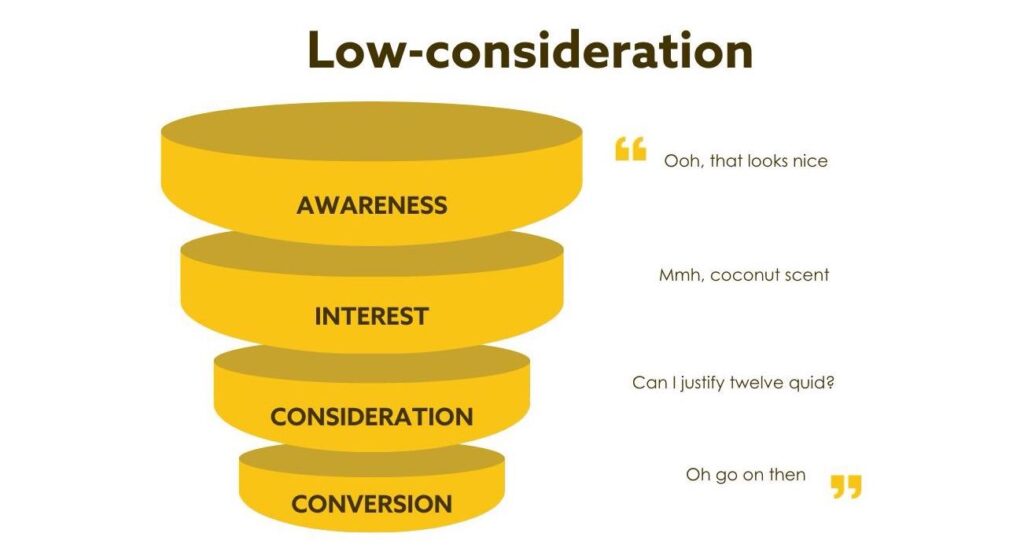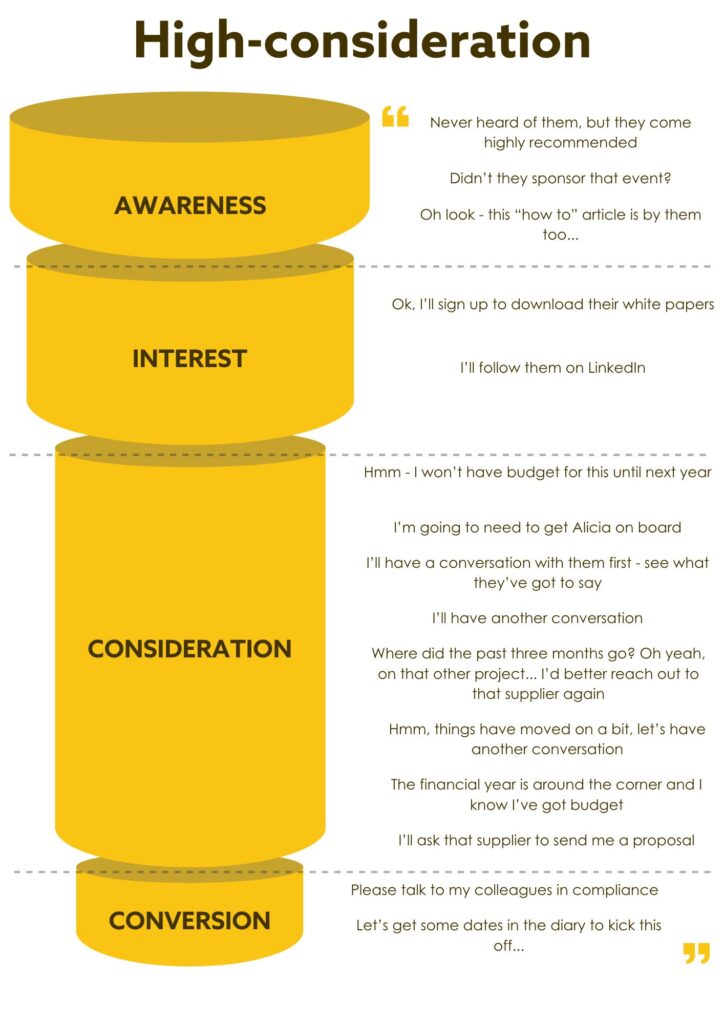When you’re watching or reading the latest marcomms thinking, do you always have a little voice in the back of your head going: “Yes, but what about B2B?”
Because while there are many similarities between B2B and B2C marketing, we all kind of know that there are differences too.
And there’s a lot of duff information circulating out there about differences between B2B and B2C comms.
Give it a quick Google, and you’ll find well-meaning articles that say things like:
- B2B marketing communications need to be more formal
- They need to be logical and process-driven because people in businesses don’t make emotional decisions
- B2B comms should use industry-specific jargon and terms
Follow this advice, and you’ll invest a lot of time creating comms that have very little impact. You’ll also gain an unrealistic view of how B2B audiences operate – and what they want and need.
In fact, this type of advice completely misses the point.
| B2C = Business to consumer Or in other words, products and services that are created for individuals. So – the stuff you buy in the supermarket, holidays, cars, household insurance… B2B = Business to business Or in other words, products and services that businesses sell to other businesses. These things could be professional services – like accountancy and consultancy. Or they could be specialist financial products – or equipment like printers or machinery. |
Stop thinking B2, and instead think consideration
The most important thing, we think, is to stop thinking in terms of B2B and B2C – because there’s an area of overlap between them.
We tend to think instead about low-consideration products and services and high-consideration products and services.
Low consideration means things you don’t consider for ages before you buy them. So things you buy in a supermarket tend to be low consideration. You might spend a couple of minutes in the shampoo aisle thinking: “Ooh that looks nice! But can I spend £12 on shampoo? Oh go on then…” But you’ve zipped through that marketing funnel like poo through a goose.

With low consideration purchases, there’s little risk. The worst that happens is you waste a few pounds on a product you don’t like. You won’t lose your job. You won’t get into financial difficulties (unless you’re buying tons of stuff you can’t afford). Making a low-consideration purchase is a low-stakes activity.
This isn’t to say that it’s easy to get people to buy low-consideration products and services. It just means that you market them a little differently.
| What makes a product or service low consideration? Generally, it’s these things: – You understand what the product is – You’ve heard of it – It’s affordable |
High consideration products and services are the ones you have to think about and plan for. In the consumer world, high-consideration purchases are things like houses, cars and executive MBAs.
In the B2B world, the vast majority of purchases are high consideration.
So we’re not talking about the sandwiches you might buy for a meeting, or a small stationery purchase. These are the purchases you need to think about and plan for within budgetary cycles. They’re the ones where your career might be on the line if you make the wrong decision. And they’re the ones where you need to persuade line managers (and sometimes their managers) to agree.
Instead of the seconds it takes you to make a decision about a consumer item, this path to purchase can take months – or even years. (We’ve had conversion happen only after the person we started the conversation with got promoted.)

| What makes a product or service high consideration? Generally, it’s these things: – You don’t quite understand what the product/service is – If the product or service turns out to be no good, you’re risking financial security and/or career security – You need to get other people to agree to the purchase happening – It’s expensive |
How does all this funnel talk help?
Thinking in terms of high and low consideration purchases gives you a clearer context to begin to think about planning your marketing – and executing your marketing communications.
Awareness
Awareness is very, very important whether you’re selling shampoo or seven-figure executive consultancy. People – whether they have a budget of a tenner or bazillions – are less likely to spend on something or someone they’ve never heard of.
Awareness in mass marketing – where you’re selling lots of lower-consideration products – can be achieved in a number of ways, including ads, social media, influencer marketing and more.
In high-consideration situations, awareness can be bolstered by ads, social media and content marketing. But recommendation is likely to be really important. It’s why people read the reviews before they book a holiday. And it’s why business relationships so often begin via recommendation.
Interest
This is the stage of the purchase journey where we say to ourselves – OK, I’ve heard of this product, I’m going to find out more about it.
For low-consideration products, it’s a great idea to provide content to feed this interest. This can be everything from Pinterest or Facebook content showing you how to use a cake mix or organise your household finances – through to beautiful Instagram images that give you an idea of what you might look like in that dress.
For high-consideration products, it’s about providing content that shows a supplier understands the context their potential client is working within. Building content ecosystems like this should give potential clients ideas and food for thought.
Consideration
For low-consideration products, this is often a very quick step. Awareness and interest can lead directly to conversion. To make super sure, low-consideration products should lean hard on communicating the benefits. Remember that £12 bottle of shampoo? If it tells you it’ll keep your frizzy hair straight for 48 hours – then boom, you’ve got a sale.
The consideration stage for high-consideration products is more about keeping a conversation going – and continuing to demonstrate that your organisation understands the potential client’s world, challenges and interests.
For high-consideration products and services, it’s important to invest in this stage – and to understand that it’s a blend of personal and marketing contact. The aim should be to shorten the consideration period… but at the same time, understanding that there are some immovables – like budget availability.
Conversion
Yay! Your customer or client is over the line.
In low-consideration purchases, the aim is now to generate loyalty. In high-consideration purchases, there should be high levels of personal contact and continued reassurance… because the conversion process itself can take weeks or months.
So what does all this mean for B2B v B2C advice?
- Don’t think that B2B purchases are devoid of emotion. They’re not. These are high stakes purchases – and high stakes drive emotion.
- In B2B purchases, relationships are hugely important. So your comms should feel like there’s a relationship.
- By all means show your process once people are interested and considering. But even the whizziest processes are not going to sell a product. Talk to potential clients about the benefits of your products or services.
- Use jargon if it makes sense to do so. But listen to the ways that people speak to each other in corporations (here’s a clue, it’s like normal people speak to one another). So don’t clog your communications up with silly business speak.
- Don’t communicate a product or service unless you completely understand it. High-consideration products are often far less tangible than a bottle of shampoo. If you ever find yourself thinking, “Oh well, the audience knows what this means… so it doesn’t matter if I don’t.” Just stop. Go and have a chat with someone who can explain the product or service to you.
Want to talk to us about B2B or high-consideration purchases? Drop us a line.
